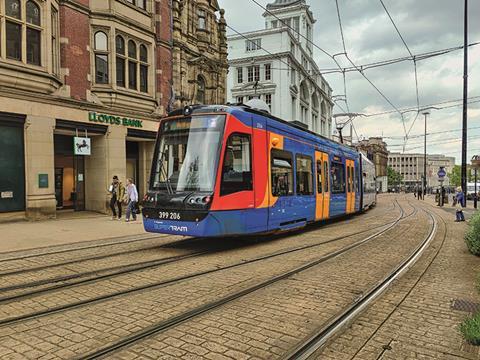Across Europe, new tram networks are driving growth, reducing congestion, and boosting productivity, while the UK’s cities remain hampered by poor transport links, high housing costs, and weak economic performance. David Milner explains why Britain is lagging behind – and why trams could be the solution

It’s 8am. The sun is peeking out from behind the clouds, and you leave your front garden near the centre of Bournemouth New Town, a new town extension. You walk five minutes to the tram stop, passing rows of new, red-brick terraces and glistening white-rendered mansion blocks that paid for most of the new tram line. Arriving at the platform, you glance up at the screen showing a three-minute wait for the tram to central Bournemouth – great, you’ll make the meeting with time for a coffee.
The ride lasts 20 minutes; it always does. The year is 2035. House prices in the city have fallen in real terms due, in part, to the large new neighbourhood halfway through being built, and the city has attracted yet another deep-tech firm to locate there, enticed by a burgeoning workforce drawn to the beaches, high salaries, and cheaper homes.
This vision sounds ridiculous right now, as new homes are lucky to have a half-hourly bus service, and housing delivery is low, but it’s the reality cities across the world have experienced after investing in new tram and metro networks anchoring bold new urban extensions.
Trams are making a comeback. Europe, in particular, has amassed over 9,000 km of track, yet the UK has only (re)built 350 km – less than 4 per cent of that – despite having 14 per cent of the population. In the three years between 2015 and 2018, Europe built more kilometres of tram line than the entirety of the UK has in operation.
This is because Britain has made it too expensive to build new tram tracks and too time-consuming and risky to achieve planning consent for them. We also don’t allow willing cities to raise and spend their money locally to deliver them.

The government’s leading mission is stimulating economic growth and tackling the foundational problem of low productivity in our cities outside London. Seven of the ten largest cities in the UK are ranked in the bottom twenty for productivity out of a total of 112 large G7 cities, according to the think tank Centre for Cities.
The three doses of medicine they recommend are planning reform, devolution, and local transport improvements. The first two now have momentum, but the final recommendation is where we fall behind our more productive peers.
But what does low-productivity urban transport mean for fellow city residents? A couple living in London can, to an extent, live anywhere in the capital under the knowledge that both can get to work without a tortuously long commute.
In Birmingham, however, one partner must surely compromise on their ideal workplace due to the lack of fast, reliable transport across the city. Cue reduced income and arguments at home.
We live in a knowledge economy where the exchange of ideas and spontaneous meetings drive growth. Yet a council worker in Solihull wishing to meet a compatriot in Dudley Council’s offices, 14 miles away, has to travel on three different types of transport, including a bus often caught in traffic, taking 1 hour 38 minutes on a good day. A council official in Greenwich, though, can hop on one tube line and travel 16 miles to Ealing Council and be there in 50 minutes, reliably and easily.
So what can be done to allow a couple to relocate to the beaches of Bournemouth? The UK’s tram renaissance will be a story in three acts:
-
Reduce the cost of tram-building by removing the cost burden of replacing most utilities. Adopt a ‘don’t move by default’ approach when constructing new lines. If you have to close the line for a weekend in six years’ time to access a cable, so be it.
-
Devolve planning, specifically the Transport and Works Act, to city authorities so they can approve projects cheaper and in months, not years. Create a ‘light’ version of this specifically for trams so they are no longer treated like heavy rail and burdened with unnecessary requirements.
-
Fund new lines not just with national money, but with value captured by consenting planning to gentle-density developments. In Northumberland, 25 per cent of a new railway line has been funded by land value capture. In the South and parts of the Midlands, this can be far, far higher. Cities should also be able to raise local taxes to fund local improvements, such as tax increment financing, business rates, and workplace parking levies.
The final act is why developers, designers, and planning officials should get their teeth into trams. If we can integrate the planning of new developments around tram lines, we can build two or even three times more homes per hectare, helping us respond to higher housing demand.
Not only this, but the value of the development will be far greater due to more floor space and the value uplift seen around new metros – around five to six per cent. Findings show that trams, rail, and metro are the only forms of transport that achieve these uplifts.
In an era of mission-led government, it should be time for trams. This is a mission that will require support nationally by setting simple standards for track and vehicle design and adjusting rules for utilities and planning.
It will require a steady pipeline of projects from cities across the UK so we can retain knowledge and procure at scale. And it will require local political champions to pioneer the first lines of this new renaissance – whether to help them build more homes on less land or to attract businesses to the city.
We want to hear from city leaders, policymakers, or just those passionate about unlocking cities’ potential who agree that in 2025, it’s now time for trams.
>> Also read: Transport and connectivity provide the key to equitable and resilient cities
Postscript
David Milner is managing director at design practice and think tank Create Streets
















4 Readers' comments